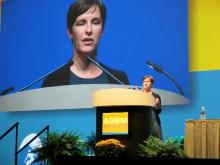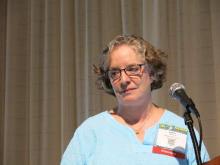HONOLULU – Modest increases in the risks of cardiac and noncardiac fetal defects in babies born from assisted reproductive technology are likely due to the increased likelihood of multiple births and not the procedures themselves, an analysis of 335,910 births suggests.
In a separate analysis, certain assisted reproductive technology methods were associated with higher or lower risks of adverse maternal and fetal outcomes, but plurality played a much bigger role in the risk of adverse outcomes.
“ART does not appear to be a major cause of birth defects; however, there are modest increases in both cardiac and noncardiac defects,” Kelly D. Getz, Ph.D., reported at the annual meeting of the American Society for Reproductive Medicine (ASRM). “The relationship between ART and birth defects is mediated through multiple birth,” a factor that may be more important for cardiac and for noncardiac defects.
“Plurality is the predominant ART treatment risk factor associated with excess morbidity for both mothers and infants,” Barbara Luke, Sc.D.said. “Other treatment factors had much less or no effect,” especially the semen source, assisted hatching, or the number of embryos transferred.
The two analyses, presented separately by Dr. Getz and Dr. Luke, were part of the Massachusetts Outcomes Study of Assisted Reproductive Technologies (ART), which linked data on births in Massachusetts between 2004 and 2008 in the Pregnancy to Early Life Longitudinal database with data from the Massachusetts Birth Defects Monitoring Program. Older age was significantly associated with the use of ART and outcomes, so the analyses adjusted for the influence of age.
A comparison of 324,148 births from spontaneous conception and 11,762 births from ART estimated prevalence ratios for patients with ART of 1.6 for any cardiac defect, septal defects, or atrial septal defects; 1.8 for ventricular septal defects; 2.1 for conotruncal and aortic arch; and 3.8 for tetralogy of Fallot.
The estimated prevalence ratios among patients with ART for noncardiac defects included 1.2 for any noncardiac defect, 1.3 for genitourinary defects, 1.5 for gastrointestinal or musculoskeletal defects, and 1.6 for hypospadias, said Dr. Getz of the Massachusetts Department of Public Health, Boston.
The prevalence of defects differed in singletons and multiples. For singletons, the prevalence of cardiac defects was 60 per 10,000 births after ART and 46/10,000 without ART. Among multiples, the prevalence of cardiac defects was 101/10,000 with ART and 91/10,000 without ART. The adjusted prevalence ratios for cardiac defects were higher in multiples with or without ART (2), compared with singletons with ART (1.1) or without ART (1, the reference group), but did not differ significantly within each subgroup based on whether or not ART was used.
Similarly, for noncardiac defects, the prevalence among singletons was 163/10,000 with ART and 133/10,000 without ART, and among multiples was 200/10,000 with ART and 179/10,000 without ART. The adjusted prevalence ratios were 1.4 for multiples with ART, 1.3 for multiples without ART, and 1.2 for singletons with ART.
A separate analysis in the study looked at maternal and fetal outcomes by various ART treatment factors, including autologous or donor oocytes, autologous or donor semen, the use or not of intracytoplasmic sperm injection or assisted zona hatching, fresh or thawed embryos, the number of embryos transferred, fetal heartbeats at 6 weeks of gestation, and plurality at birth.
Rates of adverse maternal outcomes were significantly higher in 2,422 twin pregnancies than in 6,526 singleton pregnancies, including pregnancy-induced hypertension in 25% and 13%, respectively, gestational diabetes in 10% and 8%, and a primary Cesarean section delivery in 78% and 40%, respectively, reported Dr. Luke.
Adverse fetal outcomes also were significantly more likely in twins than singletons, including preterm birth in 61% of twins and 12% of singletons, birth defects in 5% and 2%, respectively, and low birth weight in 48% and 8%. Fourteen percent of twins and 7% of singletons were small for gestational age.
Those risks were only slightly modified with adjustment for each ART treatment parameter, said Dr. Luke of Michigan State University, East Lansing, Mich.
Several ART treatment factors were associated with higher or lower risks of adverse outcomes, she added. Compared with outcomes from the use of autologous oocytes, the adjusted odds ratios with donor oocytes were 1.87 for pregnancy-induced hypertension and 1.87 and 1.43 for primary C-section and preterm birth. Using frozen rather than fresh embryos was associated with a 30% increased risk for pregnancy-induced hypertension, but also a 21% lower risk for low fetal birth weight and a 62% lower likelihood that the baby will be small for gestational age. Hearing two fetal heartbeats instead of one at 6 weeks was associated with a 49% increased risk of prematurity and a 57% increased risk of low birth weight. Hearing three or more heartbeats instead of one was associated with more than a doubling in risk for prematurity, low birth weight, or a small-for-gestational-age baby.



